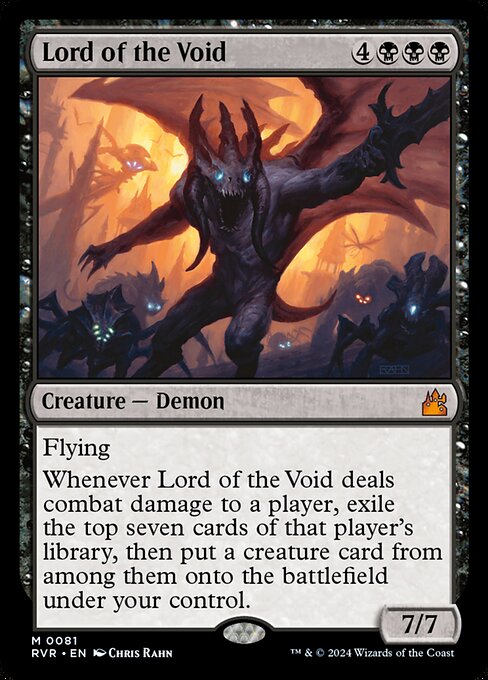
Image courtesy of Scryfall.com
From Print Run to Price Run: The Lord of the Void Reprint Story
In the vast ecosystem of Magic: The Gathering, reprints are the quiet engines that keep the game accessible while still sparking collector fervor. Lord of the Void, a formidable black demon with a 7/7 frame and wings that could scare a vampire into a nap, exemplifies this dynamic. Its most recent home—Ravnica Remastered, a Masters-set revival released on January 12, 2024—reminded the community that a card can be simultaneously fearsome on the battlefield and fascinating from a market perspective 🧙♂️🔥. With a mana cost of four generic and three black (4BB) and a flying body that hates losing, this card sits at a compelling crossroads of power, scarcity, and long-term demand 💎⚔️.
The lifecyle of a reprint in formats like Pioneer, Modern, Legacy, and Commander is a story of supply and demand colliding with nostalgia. Ravnica Remastered—the set to which Lord of the Void belongs—reintroduced a high-impact strategic option to players who value top-deck manipulation and battlefield control. The mythic rarity of the card, combined with its potent ability, tends to propel it into the radar of both players and collectors. On paper, the card is a game-warping behemoth; in practice, it becomes a prudent investment for players who anticipate shifts in a metagame hungry for big swing turns 🧙♂️🎲.
Key mechanics and how they drive value
The texture of Lord of the Void’s power is its combat trigger: when it deals combat damage to a player, exile the top seven cards of that player’s library, then put a creature card from among them onto the battlefield under your control. This is not just removal or ramp; it’s a heist on the focus of your opponent. The top of their deck becomes a potential chump-stopper or, more chillingly, a surprise threat you get to deploy from the exile pile. This dual-layered impact—board presence and late-game library manipulation—has made it a perennial favorite in Commander, where taking control of an opponent’s strategy can feel as rewarding as cracking a difficult puzzle 🧙♂️💎.
- Power and board presence: A 7/7 with flying is no joke, and black’s toolkit often leans into inevitability and recursion. Lord of the Void delivers both threat and resilience, especially in control-minded lists that can protect it while it accrues value.
- Graveyard and deck manipulation synergy: The top-seven exile clause can flood your board with a well-timed creature, turning a single swing into a momentum shift. This synergy is particularly pronounced in decks that play with blink effects or reanimator strategies
- Format versatility: Legal in Pioneer, Modern, Legacy, Vintage, and Commander, among others, which widens both its playability and its exposure to demand across the card’s lifecycle 🔥.
Market realities: supply, demand, and reprint cycles
Market data accompanying the card in its Ravnica Remastered iteration shows a realistic snapshot of modern MTG economics. Current values hover around the USD 11.24 range for a non-foil copy, with foil variants around USD 10.75. In euros, the non-foil price sits near €7.94, and foil versions clock in around €8.41. These numbers illustrate how a reprint can temper price volatility while still leaving room for value accumulation in sleeves that gleam with holofoil drama. In the grand arc of MTG finance, that delta between raw playability and collectible allure often translates into a steady, if not explosive, appreciation for the right buyer demographics 💎⚔️.
Collectors often weigh foil versus non-foil copies, with foils tending to see premium treatment in Commander playgroups and display cases. In this context, the card’s price stability is buoyed by its rarity—mythic in a Masters-set reprint—paired with evergreen demand from players who want a large, decisive creature that can dominate a game when unblocked. It’s a textbook example of how reprints can broaden access while maintaining a ceiling of desirability that keeps speculators watching the market like hawks in a throne room 🧙♂️🎨.
“When a reprint hits a card as iconic as a flying seven-seven demon, it isn’t just about the stat line—it’s about the story you tell with it on the table and in your binder.”
Gameplay implications across formats
In Commander, Lord of the Void shines as a commander-wide threat that can tilt games with a single combat swing and a carefully timed top-deck exile. In Modern and Legacy, its raw power can serve as a finisher or a stabilizer in midrange strategies, especially in black-heavy shells that can protect it and maximize its ability by generating value from the opponent’s cards. Pioneer gains the card’s heavy-hitting presence as a mana sink that rewards aggressive play and smart combat math 🔥.
From a design perspective, this reprint reinforces the enduring appeal of big, multi-format threats that reward skilled play. It’s a reminder that MTG’s economy isn’t solely about card quantity, but quality timing. The sitter on release—the curve, the interaction with other exile or theft effects, and the power to generate immediate board impact—are all facets that keep this card relevant across aging metagames 🎨⚔️.
Lore, art, and the collector’s eye
Chris Rahn’s art gives the demon a presence that feels both ancient and peerless, a visual echo of the card’s transformative ability. The mystique of a black demon breaching the veil between libraries and battlefields is exactly the kind of flavor that keeps players picking up sleeves and lore volumes alike. As with many iconic legends, the artwork adds emotional weight to the card’s mechanical promise, making it a memorable centerpiece whether you’re drafting or trading in a shop corner 🧙♂️💎.
For players watching the market, Reprints in the Ravnica Remastered era illustrate how MTG’s financial lifecycle can be both pragmatic and poetic. The card’s journey—from a high-impact threat in casual play to a sought-after collectible in modern formats—mirrors the hobby’s evolution: players chasing power, collectors chasing memory, and both groups intersecting in moments of pure, shared wonder 🎲.